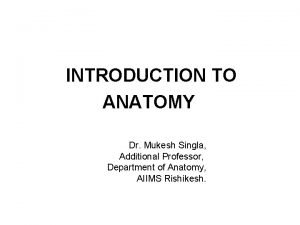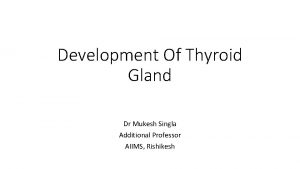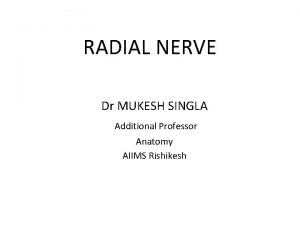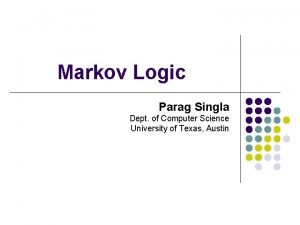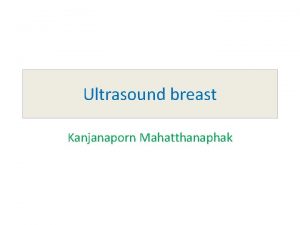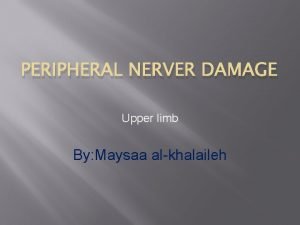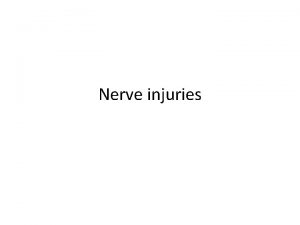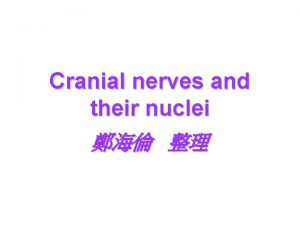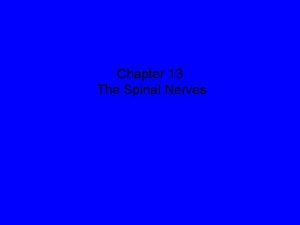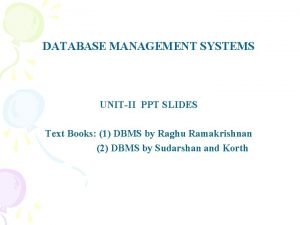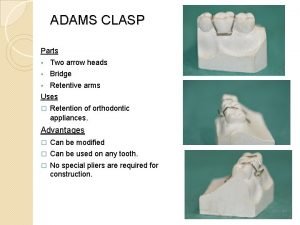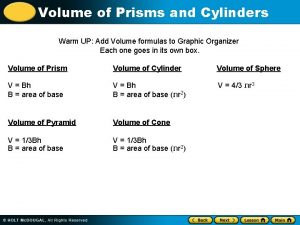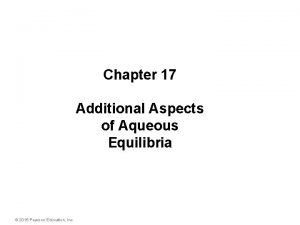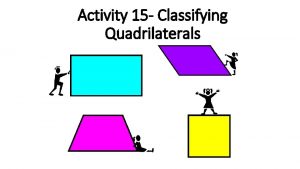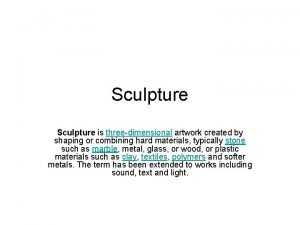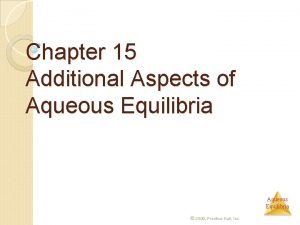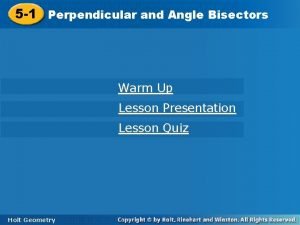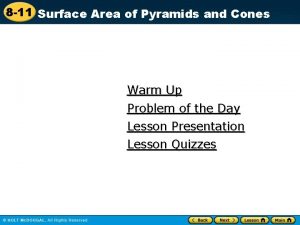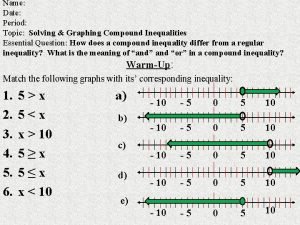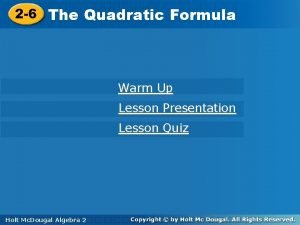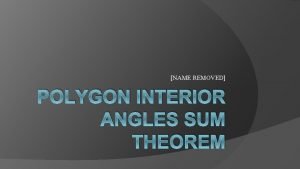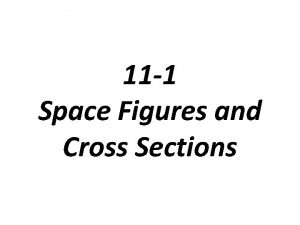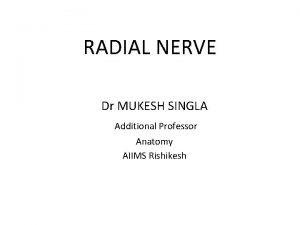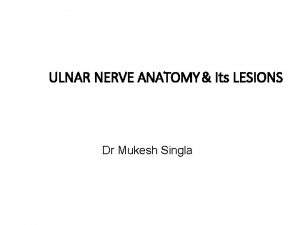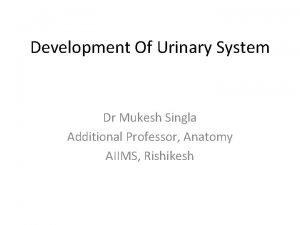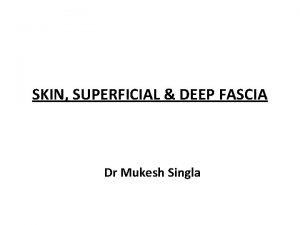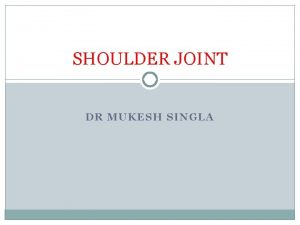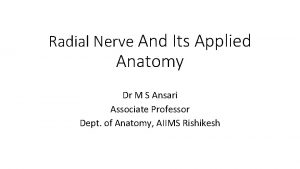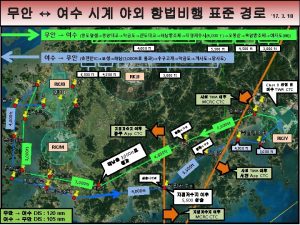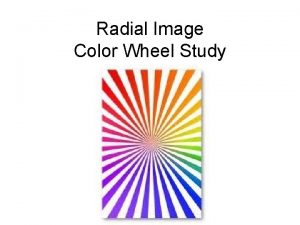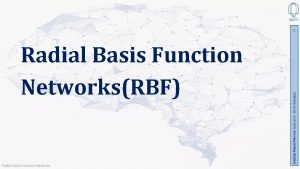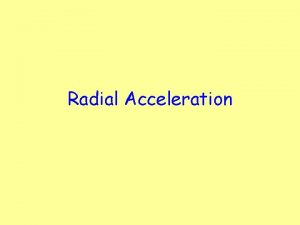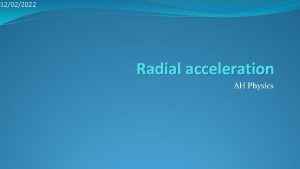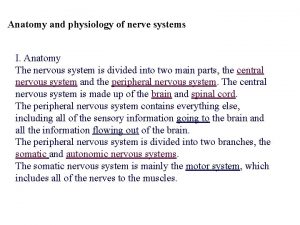RADIAL NERVE Dr MUKESH SINGLA Additional Professor Anatomy















































- Slides: 47

RADIAL NERVE Dr MUKESH SINGLA Additional Professor Anatomy AIIMS Rishikesh

Learning Objectives • Origin and root value of radial nerve. • Course and relations of radial nerve. • Branches and structures supplied by radial nerve. • Effects of lesion of radial nerve.






















• A lesion of the lower trunk of the brachial plexus will impair but not eliminate the function of which muscle? • A Biceps brachii • B Pectoralis major • C Supraspinatus • D Serratus anterior • Answer B

Injury to radial nerve in lower part of spiral groove: a) Spares nerve supply to extensor carpi radialis longus b) Results in paralysis of anconeus muscle c) Leaves extensions at elbow joint intact d) Weakens pronation movement


Tests for clinical examination of the radial nerve Motor supply - triceps, brachioradialis, and the extensor muscles of the hand. If the radial nerve is affected below the upper third of the upper arm then: brachioradialis and the extensor muscles are affected – the patient will have a wrist drop which can be demonstrated by the patient's inability to extend the wrist when his elbow is flexed and his forearm pronated. If a lesion affects the radial nerve above the upper third of the upper arm then: - function of triceps - extension of the elbow - is also affected. Sensation - injury to the radial nerve at any level will cause loss of sensation over the anatomical snuff box.

Cheiralgia paraesthetica ('handcuff neuropathy' wristwatch neuropathy') entrapment neuropathy of the radial nerve may occur at the wrist (cheiralgia paraesthetica) radial nerve at this level provides sensation to the anterior aspect of the 1 st MCPJ and the posterior lateral 3 1/2 fingers excluding the finger tips area affected is typically on the back or side of the hand at the base of the thumb, near the anatomical snuffbox, but may extend up the back of the thumb and index finger and across the back of the hand symptoms include numbness, tingling, burning or pain since the nerve branch is sensory there is no motor impairment may be distinguished from de Quervain syndrome because it is not dependent on motion of the hand or fingers

Causes of cheiralgia paraesthetica Cheiralgia paraesthetica may be seen in 1. prisoners with tight handcuffs 2. where there has been excessive struggling against a normal handcuff. 3. Tight watches, bands or bracelets may also cause this condition 4. other injuries or surgery in the wrist area can also lead to symptoms, including surgery for other syndromes such as de Quervain's Exact aetiology is unknown, as it is unclear whether direct pressure by the constricting item is alone responsible, or whether oedema associated with the constriction also contributes Management: usually settles with conservative therapy (avoidance of compression) but may take up to 2 months complete anaesthesia suggests complete severance of the radial nerve and should prompt urgent surgical referral.

Wartenberg syndrome pain over the distal radial forearm associated with paresthesias over the dorsal radial hand. They frequently report symptom magnification with wrist movement or with tight pinching of the thumb and index digit. These individuals demonstrate a positive Tinel sign over the radial sensory nerve and local tenderness. Hyperpronation of the forearm can cause a positive Tinel sign. A high percentage of these patients reveal physical examination findings consistent with de Quervain tenosynovitis.

Posterior interosseous nerve syndrome weakness or paralysis of the wrist and digital extensors. Pain may be present, but it usually is not a primary symptom. Attempts at active wrist extension often result in weak dorsoradial deviation as a consequence of preservation of the radial wrist extensors but involvement of the extensor carpi ulnaris and extensor digitorum communis. These patients do not have a sensory deficit. Rarely, compression of the posterior interosseous nerve may occur after bifurcation into medial and lateral branches.

Posterior interosseous nerve syndrome-cont. . Selective medial branch involvement causes paralysis of the extensor carpi ulnaris, extensor digiti quinti, and extensor digitorum communis. With compression of the lateral branch, paralysis of the abductor pollicis longus, extensor pollicis brevis, extensor pollicis longus, and extensor indicis proprius is noted.

• All of the following nerves arise from the posterior cord of the brachial plexus except • A Long thoracic • B Thoracodorsal • C Axillary • D Upper subscapular • E Radial

Radial nerve palsy in the middle third of the arm is characterized by palsy or paralysis of all extensors of the wrist and digits, as well as the forearm supinators. Very proximal lesions also may affect the triceps. Numbness occurs on the dorsoradial aspect of the hand the dorsal aspect of the radial three-and-ahalf digits. Sensation over the distal and lateral forearm is supplied by the lateral antebrachial cutaneous nerve and therefore is preserved

Radial tunnel syndrome pain over the anterolateral proximal forearm in the region of the radial neck. appears in individuals with work requiring repetitive elbow extension or forearm rotation. The maximum tenderness is located four fingerbreadths distal to the lateral epicondyle. (By way of comparison, with lateral epicondylitis, maximum tenderness is usually directly over the epicondyle. ) Symptoms are intensified by extending the elbow and pronating the forearm. In addition, resisted active supination and extension of the long finger cause pain. Weakness and numbness usually are not demonstrated.

In de Quervain disease, injection of cortisone and lidocaine into the tendon sheath of the extensor pollicis brevis and the abductor pollicis longus relieves the symptoms immediately and sometimes permanently. An injection of cortisone and lidocaine into the area of compression of the superficial radial nerve causes the symptoms to subside; however, numbness in the nerve distribution follows, and when the injection wears off, the symptoms return. A Tinel sign is present in patients with Wartenberg syndrome but usually not in those with de Quervain disease. The two conditions may be related. The inflammation from de Quervain disease causes an inflammation of the nerve. With resolution of one condition, the other may subside or may be adequately treated with an injection.






Regarding the radial nerve which statement is incorrect? a) It passes anterior to the lateral epicondyle of the humerus b) Injury to the radial nerve from fracture of the shaft of the humerus will result in wrist drop c) Injury to the deep radial nerve in the mid forearm will prevent extension only at the MCPJs d) Sensory loss from injury to the superficial radial nerve will usually result in loss of sensation over the entire thumb e) It is the larger terminal branch of the posterior cord of the brachial plexus


• If there is a sensory loss over a variable area on the dorsum of the hand proximal part of dorsal surface of the lateral 3 ½ fingers, the nerve damaged is • A Deep branch of radial • B Superficial branch of radial • C Lateral cutaneous nerve of forearm • D Dorsal cutaneous branch of ulnar nerve • E Palmar cutaneous branch of median nerve • Answer B

• The radial nerve gives off the following muscular branches in the arm except to • A Long head of triceps • B Brachialis • C Lateral head of triceps • D Anconeus • E Brachioradialis • Answer B


 Subdivision of anatomy
Subdivision of anatomy Tongue development
Tongue development Posterior interosseous nerve is a branch of
Posterior interosseous nerve is a branch of Parag singla
Parag singla Adish singla
Adish singla Adbuctive
Adbuctive Anti radial vs radial ultrasound
Anti radial vs radial ultrasound Promotion from assistant to associate professor
Promotion from assistant to associate professor Profunda brachii artery
Profunda brachii artery Tinel's sign
Tinel's sign Radial nerve supply
Radial nerve supply Radial nerve pathway
Radial nerve pathway Trigeminal nerve which cranial nerve
Trigeminal nerve which cranial nerve Hybrid framework interview questions
Hybrid framework interview questions Mukesh ambani signature
Mukesh ambani signature Mukesh png text
Mukesh png text How to explain bdd framework in interview
How to explain bdd framework in interview Spinal cord nerve anatomy
Spinal cord nerve anatomy Database system ppt
Database system ppt Inclined plane
Inclined plane Unit 12 additional needs
Unit 12 additional needs Additional topics in trigonometry
Additional topics in trigonometry Prisms and cylinders worksheet
Prisms and cylinders worksheet Askov in public health dentistry
Askov in public health dentistry Additional aspects of aqueous equilibria
Additional aspects of aqueous equilibria Additional process
Additional process Additional member system scotland
Additional member system scotland 5-3 additional vocabulary support bisectors in triangles
5-3 additional vocabulary support bisectors in triangles Legs of a trapezoid
Legs of a trapezoid A letter asking for information
A letter asking for information Uc application personal statement
Uc application personal statement A 3-d work of art created by shaping or combining materials
A 3-d work of art created by shaping or combining materials Additional support for learning act 2004
Additional support for learning act 2004 Additional aspects of aqueous equilibria
Additional aspects of aqueous equilibria Pros and cons of ams
Pros and cons of ams Perpendicular and angle bisectors worksheet
Perpendicular and angle bisectors worksheet Additional roles reimbursement scheme
Additional roles reimbursement scheme Formula for pyramid surface area
Formula for pyramid surface area Askov dental demonstration
Askov dental demonstration Grantham additional needs fellowship
Grantham additional needs fellowship 1-6 additional practice compound inequalities
1-6 additional practice compound inequalities Attach additional responsibilities to an object dynamically
Attach additional responsibilities to an object dynamically 10-5 secant lines and segments
10-5 secant lines and segments Fire watchers are additional personnel
Fire watchers are additional personnel Fsmq maths
Fsmq maths 2-6 additional practice the quadratic formula
2-6 additional practice the quadratic formula Polygon interior angle sum theorem
Polygon interior angle sum theorem 11-1 space figures and cross sections answer key
11-1 space figures and cross sections answer key
